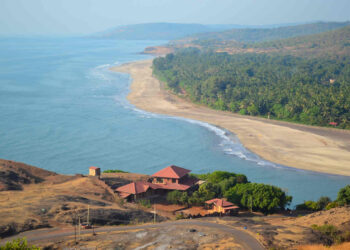Located in the busy streets of Ahmedabad, Gujarat, the Hutheesing Jain Temple is a holy abode of Lord Dharmanath, the 15th Jain Tirthankara. Built back in 1848 by the Hutheesing family, this temple, with its white marble and fine carvings, calls to those looking for peace. If you’re planning to come to this sacred place, here’s a plain guide about its story, what it’s like, its prayers, and how to get there.
Fun Fact: The temple’s 78-foot tower, called Mahavir Stambh, was put up later, taking after one in Chittorgarh.
Mythological Importance
Hutheesing Jain Temple has old Jain stories. One tale says Lord Dharmanath, born long ago, left his throne to find truth and became a Tirthankara, showing folks the way to freedom. Another story tells of a wealthy trader, Hutheesing Kesarisinh, of Ahmedabad praying here for a child, and his wish came true after he promised a big temple. As a main Jain shrine, it’s tied to the teachings of non-violence and clean living from Tirthankaras.
Historical Overview
The temple was made in 1848 by Sheth Hutheesing Kesarising, a rich Jain merchant, when the British ruled. Ahmedabad was a trade town, and Jains were strong there. Work began in 1847, but Hutheesing passed away, so his wife, Shethani Harkunvar, finished it, spending ₹10 lakh (equivalent to ₹75 crore or US$8.9 million in 2023). In the 1860s, they added a tower. By the 1900s, it was a big Jain place. After 1947, the Hutheesing Jain Trust took over. Fixes in the 1990s kept its old look. Jain monks long ago told its tale in talks. Now, many visit Ahmedabad’s holy ground.
The temple’s past is full. Old Jain books from the 1800s talk of its beauty. British notes from then say it’s fine work. Sketches found from 1847 show how it was planned.
Architecture of Hutheesing Jain Temple
Salat has blended the old temple architecture style with new architectural elements of haveli in designing the temple. Hutheesing Jain Temple sits on two acres in Ahmedabad’s Madhupura, built in Jain style. The main part, from 1848, has a three-story spire with carvings of Dharmanath sitting, lotus blooms, and Jain signs, all in white marble. Inside, there’s a 2-foot marble statue of Dharmanath, legs crossed, calm in thought, lit by soft lamps. The inner walls have marble slabs with Jain prayers.
It is a nirandhara-prasada type of the temple which do not feature an ambulatory passage. The west-facing temple is built on a large platform. The principal temple has three sanctuaries in a row: a garbhagriha (sanctum), a gudhamandapa (closed shrine hall with porches), a vestibule and a sabhamandapa (assembly hall), each having its own shikhara. The principal temple is 52.5 metre high and double-stories. The garbhagriha on the east end has three ornate spires. The large ridged dome of the gudhamandapa is supported by twelve ornate pillars.
There’s a hall with 52 little rooms, each with a Tirthankara statue, carved with elephants and gods. Small shrines for Parshvanath, Shantinath, and Mahavir are in the yard, made of marble. The Parshvanath one shows him with a snake hood, for safety. The Shantinath one, from 1850, has him sitting, for quiet. The Mahavir one shows him teaching, for truth. The grounds, with marble floors, feel holy, near the Sabarmati River. A 78-foot tower, Mahavir Stambh, stands at the gate. A water tank for rituals has carved steps. Pillars tell Jain stories, showing the way. The spire’s carvings look bright.
Rituals and Festivals
The temple hums when festivals come. Paryushan, in August or September, is the big one, with eight days of fasting and praying. Mahavir Jayanti, in April, marks Mahavir’s birth with a march. Diwali, in October or November, honors Mahavir’s final peace with lamps. Kartik Purnima, in November, brings walks for pilgrims. Samvatsari, in Paryushan, is for saying sorry.
Each day, they start with Prakshal at dawn, washing statues with water. Aarti at 7:00 AM uses lamps. Evening aarti at 6:30 PM ends things. Special prayers, like Snatra Puja, cost ₹100-300 and bring blessings.
Information for Travelers
Hours and Entry: Open every day, 6:00 AM to 7:00 PM. It’s free to enter, but prayers cost ₹100-300. No pictures in the inner room.
Clothing: Wear clothes that cover shoulders and knees. Women for prayers wear sarees or suits, men wear kurtas.
How to Get There:
Air: Ahmedabad Airport, 8 km away, is close. Taxis take 20 minutes, cost ₹200-400.
Train: Ahmedabad Junction, 4 km off, links to Mumbai (7 hours). Autos cost ₹50-100.
Road: Buses from Gandhinagar (30 minutes) come to Ahmedabad. Taxis cost ₹500-800. Roads are full.
Places to Stay: Ahmedabad has guesthouses like Hotel Royal (₹1000-2000). Hotels like Hyatt Regency (₹3000-5000) are comfy. Stalls sell khaman, fafda, and tea.
Best Time to Visit: October to March is cool, 20-30°C. Weekdays are calm. Paryushan’s busy, so plan early.
Nearby Attractions:
Sabarmati Ashram, 5 km away, is Gandhi’s home.
Adalaj Stepwell, 15 km away, is a carved well.
Jama Masjid, 2 km away, is an old mosque.
Sidi Saiyyed Mosque, 2 km away, has stone screens.
Kankaria Lake, 7 km away, is a pretty spot.
Final Thoughts
Hutheesing Jain Temple in Ahmedabad, Gujarat, a holy place in western India, is a treasure for the heart. Lord Dharmanath’s pure touch reaches all who visit, making it a spot you must see among India’s sacred places.











